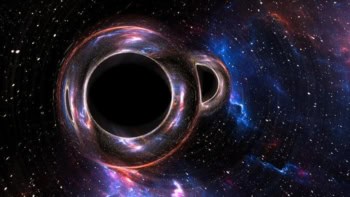The black hole at the centre of our galaxy has a strong influence on its surroundings. Astronomers cannot yet see this 3.6 million solar mass behemoth directly but they have now witnessed flashes of infrared light emitted breathtakingly close to its event horizon. Remarkably, they observed periodic bursts of infrared radiation coming from the black hole which, they say, is evidence for its rotation (R Genzel et al. 2003 Nature 425 934)
The centre of our galaxy lies within a cluster of stars in the constellation Sagittarius. Though hidden behind a dusty cloud of gas, a bright radio source known as Sagittarius A* marks the spot where over three million solar masses of dark matter have collapsed to form a highly concentrated source of gravity. Some 10 million stars swarm within a light-year of Sagittarius A*, and at least three or four of them have been seen to swing within a few light-days of it.
Using one of the four dishes in the Very Large Telescope (VLT) in Chile, Reinhard Genzel of the Max Planck Institute for Extraterrestrial Physics in Garching, together with colleagues in Germany, Israel and France, was surprised to find that the infrared light produced by Sagittarius A* during an explosion is actually modulated with a period of only 17 minutes. This cyclic repetition is almost certainly associated with the orbital motion of the hot gas around the black hole.
For a black hole with a mass of 3.6 million solar masses, such an orbital period means the emitting region is only one-tenth the distance between the Earth and the Sun above the event horizon.
In the January issue of Physics World Fulvio Melia in the Department of Physics and Steward Observatory at the University of Arizona in the US describes these results in more detail.



